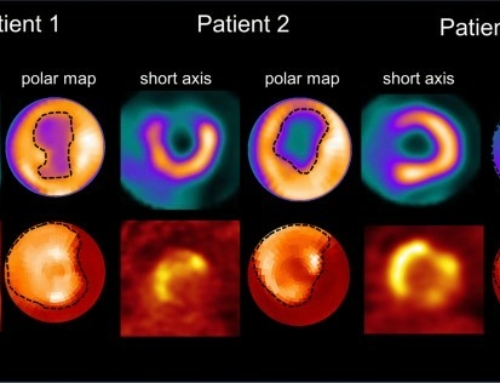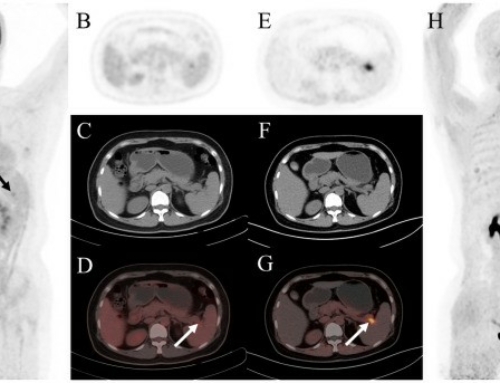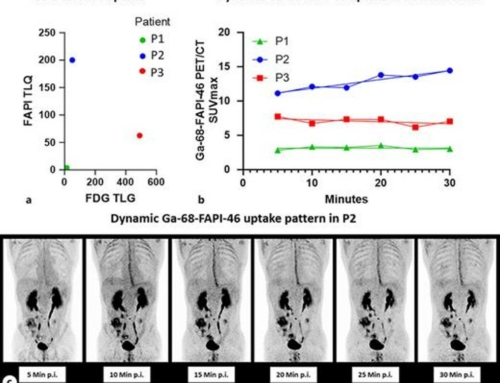Purpose: This prospective study aimed to evaluate the potential usefulness of [68Ga]Ga-DOTA-FAPI-04 positron emission tomography/computed tomography (PET/CT) in the oncological evaluation of patients presenting with inconclusive [18F]FDG PET/CT findings.
Methods: [68Ga]Ga-DOTA-FAPI-04 was performed in patients presenting with inconclusive [18F]FDG PET/CT findings. Tumour uptake was quantified by the maximum standard uptake value (SUV). Histopathology or follow-up imaging served as the standard for the final diagnosis.
Results: A total of 68 patients with inconclusive [18F]FDG PET/CT findings underwent additional [68Ga]Ga-DOTA-FAPI-04 PET/CT. Of them, 18 (26.5%) were for discrimination of mass lesions detected on conventional imaging, 6 (8.8%) for detection of the unknown primary site in biopsy-proven metastatic malignancy, 21 (30.9%) for the staging of cancer, and the other 23 (33.8%) for evaluation of suspected disease recurrence. Most of the primary and metastatic lesions demonstrated higher uptake of [68Ga]Ga-DOTA-FAPI-04 than did [18F]FDG, which resulted in favourable tumour-to-background contrast in various types of cancer. As a result, [68Ga]Ga-DOTA-FAPI-04 PET/CT identified suspicious mass lesions with an accuracy of 12/18 (66.7%), detected the primary site in 4/6 patients (66.7%) with unknown malignancy, upgraded tumour staging in 7/21 patients (33.3%), and detected disease recurrence in 20/23 patients (87.0%).
Conclusions: In patients undergoing oncological evaluation with inconclusive [18F]FDG PET/CT findings, [68Ga]Ga-DOTA-FAPI-04 may have a complementary role in discriminating mass lesions on conventional imaging, locating the primary site of unknown malignancy, modifying tumour staging, and detecting suspected disease recurrence. Nevertheless, careful attention should be paid when reading the [68Ga]Ga-DOTA-FAPI-04 PET/CT images in tumours complicated with inflammation.
Affiliations:
- Department of Nuclear Medicine & Minnan PET Center, Xiamen Cancer Center, The First Affiliated Hospital of Xiamen University, Teaching Hospital of Fujian Medical University, Xiamen, China. leochen0821@foxmail.com.
- Department of Radiation Oncology, Xiamen Cancer Center, The First Affiliated Hospital of Xiamen University, Teaching Hospital of Fujian Medical University, Xiamen, China.
- Department of Nuclear Medicine & Minnan PET Center, Xiamen Cancer Center, The First Affiliated Hospital of Xiamen University, Teaching Hospital of Fujian Medical University, Xiamen, China.
- Department of Radiology, The First Affiliated Hospital of Xiamen University, Teaching Hospital of Fujian Medical University, Xiamen, China.
- Department of Colorectal Tumor Surgery, Xiamen Cancer Center, The First Affiliated Hospital of Xiamen University, Teaching Hospital of Fujian Medical University, Xiamen, China.
- Department of Medical Oncology, Xiamen Cancer Center, The First Affiliated Hospital of Xiamen University, Teaching Hospital of Fujian Medical University, Xiamen, China.
- Department of Nuclear Medicine, Jieyang Affiliated Hospital, SunYat-sen University, Jieyang, China.
- Department of Nuclear Medicine & Minnan PET Center, Xiamen Cancer Center, The First Affiliated Hospital of Xiamen University, Teaching Hospital of Fujian Medical University, Xiamen, China. 13178352662@163.com.
- Department of Nuclear Medicine & Minnan PET Center, Xiamen Cancer Center, The First Affiliated Hospital of Xiamen University, Teaching Hospital of Fujian Medical University, Xiamen, China. wuhua1025@163.com.

![Usefulness of [ 68 Ga]Ga-DOTA-FAPI-04 PET/CT in patients presenting with inconclusive [ 18 F]FDG PET/CT findings](https://sofie.com/wp-content/uploads/2021/04/Usefulness-of-68-GaGa-DOTA-FAPI-04-PETCT-in-patients-presenting-with-inconclusive-18-FFDG-PETCT-findings.png)
![Efficacy of [68Ga]Ga-FAPI-PET as a non-invasive evaluation method of liver fibrosis](https://sofie.com/wp-content/uploads/2025/06/info.ibamolecular-500x383.png)
![Comparison of [99mTc]Tc-FAPI SPECT/CT and [18F]FDG PET/CT as predictive biomarkers for immunotherapy response in gastrointestinal cancer](https://sofie.com/wp-content/uploads/2025/06/info.ibamolecular-500x383.jpg)


